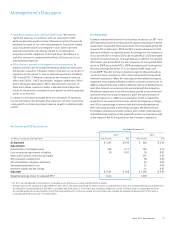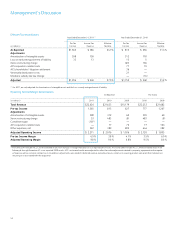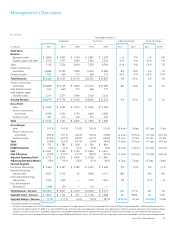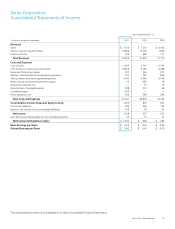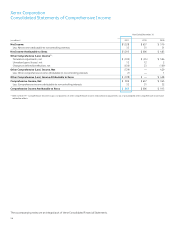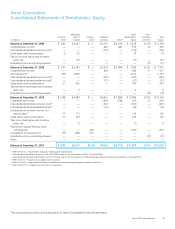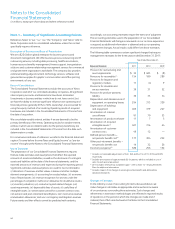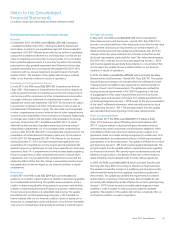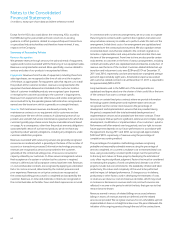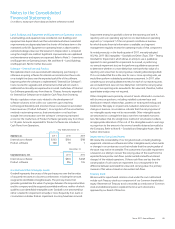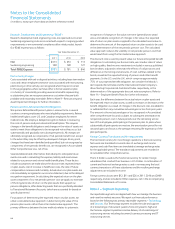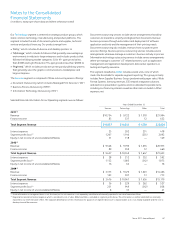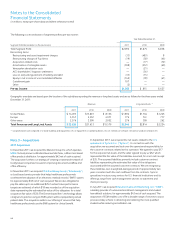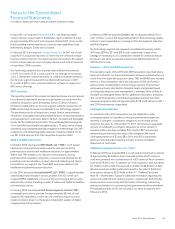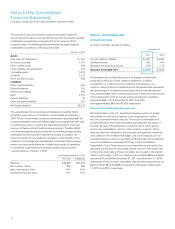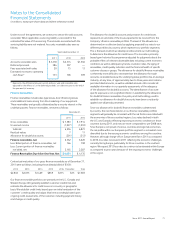Xerox 2011 Annual Report Download - page 63
Download and view the complete annual report
Please find page 63 of the 2011 Xerox annual report below. You can navigate through the pages in the report by either clicking on the pages listed below, or by using the keyword search tool below to find specific information within the annual report.61Xerox 2011 Annual Report
New Accounting Standards and Accounting Changes
Goodwill:
In September 2011, the FASB issued ASUNo.2011-08, Intangibles
– Goodwill and Other (Topic 350) – Testing Goodwill for Impairment,
which allows an entity to use a qualitative approach to test goodwill for
impairment. ASU 2011-08 permits an entity to first perform a qualitative
assessment to determine whether it is more likely than not that the fair
value of a reporting unit is less than its carrying value. If it is concluded
that a potential exposure exists, it is necessary to perform the currently
prescribed two-step goodwill impairment test. Otherwise, the two-step
goodwill impairment test is not required. We adopted ASU 2011-08 in
connection with our annual impairment test performed in the fourth
quarter of 2011. The adoption of this update did not have a material
effect on our financial condition or results of operations.
PresentationofComprehensiveIncome:
In June 2011, the FASB issued ASU2011-05, Comprehensive Income
(Topic 220) – Presentation of Comprehensive Income, which requires an
entity to present the total of comprehensive income, the components of
net income, and the components of other comprehensive income either
in a single continuous statement of comprehensive income or in two
separate but consecutive statements. ASU 2011-05 eliminates the option
to present the components of other comprehensive income as part of
the Statement of Shareholders’ Equity. The items that must be reported
in other comprehensive income or when an item of other comprehensive
income must be reclassified to net income were not changed. Additionally,
no changes were made to the calculation and presentation of earnings
per share. In December 2011, the FASB issued ASU 2011-12, which
deferred the effective date of guidance pertaining to the reporting of
reclassification adjustments out of accumulated other comprehensive
income in ASU 2011-05. ASU 2011-12 reinstated the requirements for the
presentation of reclassifications that were in place prior to the issuance
of ASU 2011-05. We adopted ASU 2011-05 effective for our fiscal year
ending December 31, 2011 and have retrospectively applied the new
presentation of comprehensive income to prior periods presented. We
elected to present comprehensive income in two separate but consecutive
statements. Note 19 – Comprehensive Income provides details regarding
the gross components of other comprehensive income, reclassification
adjustments out of accumulated other comprehensive income and the
related tax effects. Other than the change in presentation and disclosure,
the update did not have an impact on our financial condition or results
of operations.
Receivables:
In April 2011, the FASB issued ASU2011-02, to provide additional
guidance on a creditor’s determination of whether a restructuring qualifies
as a troubled debt restructuring. This guidance was provided to assist a
creditor in determining whether it has granted a concession and whether
a debtor is experiencing financial difficulties for purposes of determining
if a restructuring constitutes a troubled debt restructuring. The update
was effective for our third quarter beginning July 1, 2011 and did not
have a material effect on our financial condition, results of operations or
disclosures, as renegotiations and modifications of our finance receivables
only occur on a limited basis and typically do not have a material impact.
FairValueAccounting:
In May 2011, the FASB issued ASU2011-04, which amended Fair
Value Measurements and Disclosures – Overall (ASC Topic 820-10) to
provide a consistent definition of fair value and ensure that the fair value
measurement and disclosure requirements are similar between U.S.
GAAP and International Financial Reporting Standards. ASU 2011-04
changes certain fair value measurement principles and enhances the
disclosure requirements, particularly for Level 3 fair value measurements.
ASU 2011-04 is effective for our fiscal year beginning January 1, 2012
and must be applied prospectively. Early adoption is not permitted. We
do not expect this update to have a material effect on our financial
condition or results of operations.
In 2010, the FASB issued ASUNo.2010-06, which amended Fair Value
Measurements and Disclosures – Overall (ASC Topic 820-10). This update
required a gross presentation of activities within the rollforward of Level
3 measurements and added a new requirement to disclose transfers in
and out of Level 1 and 2 measurements. The update also clarified the
existing disclosure requirements in ASC 820-10 regarding: i) the level
of disaggregation of fair value measurements; and ii) the disclosures
regarding inputs and valuation techniques. This update was effective for
our fiscal year beginning January 1, 2010 except for the gross presentation
of the Level 3 rollforward information, which was effective for our fiscal
year beginning January 1, 2011. The principal impact from this update
was expanded disclosures regarding our fair value measurements.
OtherAccountingChanges:
In December 2011, the FASB issued ASU2011-11, Balance Sheet
(Topic 210), Disclosures about Offsetting Assets and Liabilities. ASU
2011-11 requires entities to disclose both gross information and net
information about both instruments and transactions eligible for offset
in the Balance Sheet and instruments and transactions subject to an
agreement similar to a master netting arrangement to enable users of its
financial statements to understand the effects of offsetting and related
arrangements on its financial position. This update is effective for our fiscal
year beginning January 1, 2013 and must be applied retrospectively. The
principle impact from this update will be to expand disclosures regarding
our financial instruments. We currently report our derivative assets and
liabilities on a gross basis in the Balance Sheet even in those instances
where offsetting may be allowed under a master netting agreement.
In 2009, the FASB issued ASU2009-16, which amended Transfers and
Servicing (ASC Topic 860): Accounting for Transfers of Financial Assets.
This update removed the concept of a qualifying special-purpose entity
and removed the exception from applying consolidation guidance to
these entities. This update also clarified the requirements for isolation
and limitations on portions of financial assets that are eligible for sale
accounting. We adopted this update effective for our fiscal year beginning
January 1, 2010. Certain accounts receivable sale arrangements were
modified in order to qualify for sale accounting under this updated
guidance. The adoption of this update did not have a material effect on
our financial condition or results of operations.
Notes to the Consolidated
Financial Statements
(in millions, except per-share data and where otherwise noted)


